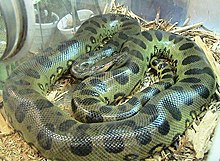Eunectes
| Anacondas | |
|---|---|

| |
| Green anaconda, E. murinus | |
| Scientific classification | |
| Kingdom: | |
| Phylum: | |
| Subphylum: | |
| Class: | |
| Order: | |
| Suborder: | |
| Family: | |
| Subfamily: | |
| Genus: | Eunectes |
| Type species | |
| Eunectes murinus | |
| Synonyms | |
- Common names: anacondas.
Eunectes is a genus of boas found in tropical South America. They are an aquatic group of snakes and include one of the largest snakes in the world, E. murinus, the green anaconda. The name Eunectes is derived from the Greek word Eυνήκτης, which means "good swimmer". Four species are currently recognized.[2][3]
Geographic range
Found in tropical South America from Colombia and Venezuela south to Argentina.[1]
Feeding
All four species are aquatic snakes that prey on other aquatic animals, including fish, river fowl, caiman, and capybaras. Some accounts exist of anacondas preying on domestic animals such as goats[citation needed] that venture too close to the water.
Relationship with humans
While encounters between people and anacondas may be dangerous, they do not regularly hunt humans. Nevertheless, threat from anacondas is a familiar trope in comics, movies and adventure stories set in the Amazon jungle. Anacondas have also figured prominently in South American folklore, where they are sometimes depicted as shapeshifting mythical creatures called encantados. Local communities and some European explorers have given accounts of giant anacondas, legendary snakes of much greater proportion than any confirmed specimen.
Species
| Species | Taxon author | Subspecies other than nominate[2] |
Common name | Geographic range |
|---|---|---|---|---|
| E. beniensis | Dirksen, 2002[4] | 0 | Bolivian anaconda | South America in the Departments of Beni and Pando in Bolivia.[3] |
| E. deschauenseei | Dunn and Conant, 1936[2] | 0 | Dark-spotted anaconda | South America in northeastern Brazil and coastal French Guiana.[1] |
| E. murinus | (Linnaeus, 1758)[2] | 1 | Green anaconda | South America in countries east of the Andes, including Colombia, Venezuela, the Guianas, Ecuador, Peru, Bolivia, Brazil and on the island of Trinidad.[1] |
| E. notaeus | Cope, 1862[2] | 0 | Yellow anaconda | South America in eastern Bolivia, southern Brazil, Paraguay and northeastern Argentina.[1] |
See also
References
- ^ a b c d e f McDiarmid RW, Campbell JA, Touré T. 1999. Snake Species of the World: A Taxonomic and Geographic Reference, vol. 1. Herpetologists' League. 511 pp. ISBN 1-893777-00-6 (series). ISBN 1-893777-01-4 (volume).
- ^ a b c d e "Eunectes". Integrated Taxonomic Information System. Retrieved 18 July 2008.
- ^ a b Eunectes beniensis at the Reptarium.cz Reptile Database. Accessed 12 December 2008.
- ^ Dirksen, L. (2002). Anakondas (in German). Münster: Natur und Tier Verlag.
Further reading
- Eunectes at the Reptarium.cz Reptile Database. Accessed 18 July 2008.
- Dirksen L.; and Böhme W. (2005). "Studies on anacondas III. A reappraisal of Eunectes beniensis Dirksen, 2002, from Bolivia, and a key to the species of the genus Eunectes Wagler, 1830 (Serpentes: Boidae)". Russian Journal of Herpetology. 12 (3): 223–229.
{{cite journal}}: CS1 maint: multiple names: authors list (link) - Wagler, J. G. (1830). Natürliches System der Amphibien, mit vorangehender Classification der Säugetiere und Vögel. Ein Beitrag zur vergleichenden Zoologie (in German). München, Stuttgart, and Tübingen: Cotta.
